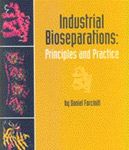Bringing Certainties to a Burgeoning Field
A well-balanced guide to industrial bioseparations provides valuable information.
Book reviewers come in all stripes. They are generally perceived to be experts in the discipline that is the subject of the book. Their extensive knowledge of the subject permits them to judge the correctness and depth of the information being imparted by the author.

Industrial Bioseparations: Principles and Practice by Daniel Forciniti, Wiley-Blackwell, Oxford, UK, 2008, 309 pp., ISBN: 978-0813820859
Daniel Forciniti conveys a great deal of information in an impressive work called Industrial Bioseparations. Given the breadth of this burgeoning field, few are qualified to review this book.
But the novice (such as myself) may perhaps also serve as a reviewer. He or she can attest to the author's helpful guidance, to the principles that form the structure of the book, and to the aptness of the tools and practices the author uses to teach the reader about the subject. In this sense, the reviewer's critique reflects his or her experience reading the book.
In the book's preface, Forciniti refers to the wealth of biotechnological advances that now produce therapeutic drugs and other compounds. Because the end products are often proteins made from the genetically altered cells of organisms such as bacteria, plants, and animals, they must be isolated from the fermentation mixes that produce them. The techniques required for this purpose derive from biological operations that require engineering skills based on the physical sciences. These skills have seldom, if ever, been dedicated to the resolution of such complexities. It should be emphasized that more than an elementary knowledge of both the biological and physical sciences is required for this isolation, in a combination that translates into an engineering application.
Forciniti undertakes and achieves his goal of teaching the principles and activities involved in bioseparations engineering practices. He teaches in the definitive language of mathematics, and his approach to technical causes and effects will oblige the purists who require certainties. Those secure in conclusions based on thermodynamics will applaud Forciniti's mathematical logic. His language is impressively clear and exceptionally instructive and explanatory.
The book discusses the production and purification of biomacromolecular entities. It thoroughly explains solid– solid, solid–liquid, and liquid–liquid separations. The principles that define the various states of matter are made plain in the book. The requisite techniques for isolating and purifying the diverse products are considered and evaluated in abundant detail. The techniques of flocculation, centrifugation, filtration, chromatography, and precipitation are investigated. Discussions of cell disruptions, protein molecular structures, freeze-drying, osmosis, and reverse osmosis are not neglected.
The book also offers practical information that extends to pertinent materials and methods, even to pumps, valves, and mixers as well as to separation cascades and types of chromatography and centrifugation. The breadth of Forciniti's coverage of technical topics is awesome.
In dealing with solid–liquid separations, Forciniti discusses the one discipline with which the reviewer has some technical familiarity (namely, filtration). The book discusses the materials and methods of conventional industrial filtrations dealing with the plate-and-frame system and rotarydrum, vacuum-activated equipment. Forciniti also discusses unconventional filtrations such as ultrafiltration and microfiltration in both the dead-end and cross-flow modes. He explains Darcy's Law both mathematically and verbally in satisfying detail.
Forciniti is obviously familiar with the finer filtrations based on membranes in large-scale pharmaceutical manufacturing and in making semiconductor chips. He cites appropriate sources and literature on the subject of filter manufacturing.
The book, necessarily limited at 309 pages, provides a surprising amount of operational details and imparts valuable information to the reader. As Forciniti made evident in the preface to his book, he did not wish to design an encyclopedic work, but rather a well-balanced book. He attained his goal with considerable distinction. This volume will serve as an invaluable introduction and guide to those embarking on careers in the discipline of bioseparations. Foriciniti deserves our thanks for promoting knowledge of this important endeavor.
Theodore H. Meltzer, PhD, is a principal at Capitola Consultancy, 8103 Hampden Ln.,Bethesda, MD 20814-1244, tel. 301.986.8640, theodorehmeltzer@hotmail.com

Drug Solutions Podcast: A Closer Look at mRNA in Oncology and Vaccines
April 30th 2024In this episode fo the Drug Solutions Podcast, etherna’s vice-president of Technology and Innovation, Stefaan De Koker, discusses the merits and challenges of using mRNA as the foundation for therapeutics in oncology as well as for vaccines.
Pharmaceutical Tariffs Are Imminent: How Industry is Bracing for Impact
April 16th 2025On April 14, 2025, the Trump Administration launched a national security-driven investigation into pharmaceuticals, a move that will likely result in tariffs being placed on pharmaceutical drugs, ingredients, and other components that are imported from outside of the United States.